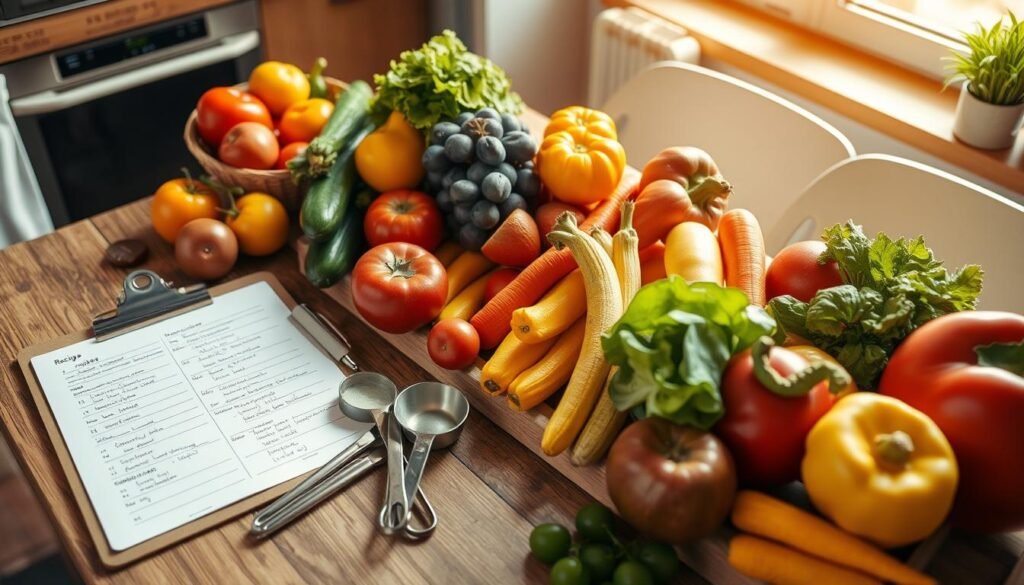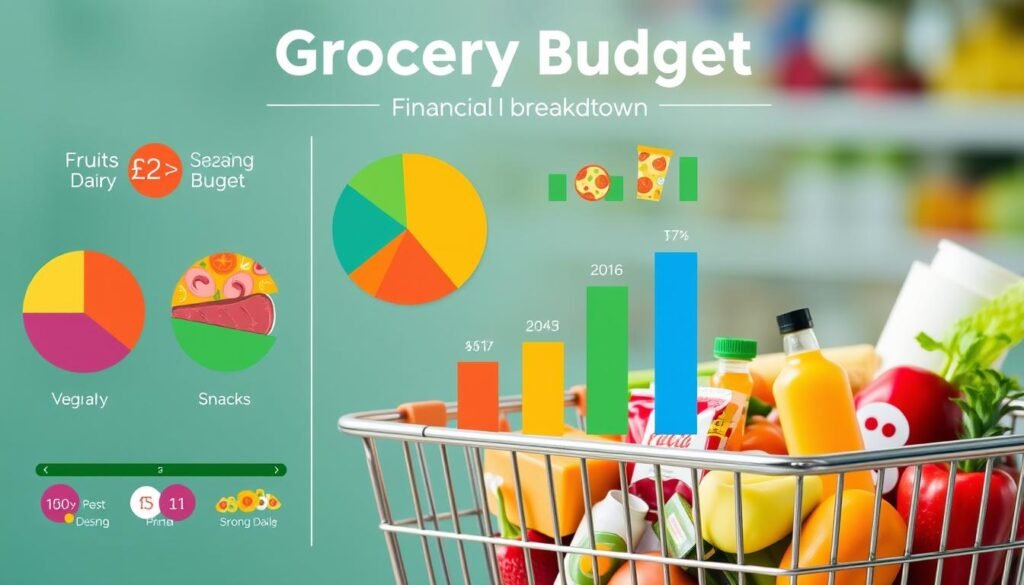Planning a family vacation but worried about the cost of food? Don’t worry! Finding ways to save on groceries can make your trip more affordable. We’ll share budget-friendly tips to help you save money on groceries for your family trips.
Key Takeaways
- Leverage meal planning strategies to maximize your grocery budget
- Explore versatile, cost-effective ingredients for nutritious family meals
- Prioritize sales, discounts, and coupons to stretch your grocery dollars
- Establish a realistic weekly grocery budget for your family
- Discover budget-friendly shopping destinations and loyalty programs
Meal Planning Strategies
Planning meals is key to saving money on groceries for family trips. Using versatile ingredients for multiple meals cuts down on waste and boosts grocery value. Getting creative with leftovers also helps save money and reduces waste.
Utilizing Versatile Ingredients
Having versatile ingredients in your kitchen makes it easy to cook affordable meals on the go. Focus your meal plan on items like chicken, beans, grains, and seasonal produce. These can be used in many dishes, letting you create different meals all week.
- Chicken: Use it in stir-fries, casseroles, or shred it for sandwiches and wraps.
- Beans: Incorporate them into soups, chilis, or serve them as a side dish.
- Grains: Cook extra quinoa or rice to use in salads, bowls, or as a base for other meals.
- Seasonal Produce: Take advantage of what’s in season to save money and add fresh flavors to your dishes.
Planning meals with these versatile ingredients helps stretch your grocery budget and reduce waste. This makes meal planning more efficient and cost-effective for family trips.
“Meal planning can help prevent excess food waste by ensuring you only buy what you need.”

| Ingredient | Versatile Uses | Typical Cost |
|---|---|---|
| Chicken | Stir-fries, casseroles, sandwiches, wraps | $3-$5 per pound |
| Beans | Soups, chilis, side dishes | $0.50-$1 per can |
| Quinoa | Salads, bowls, side dishes | $3-$5 per pound |
| Seasonal Produce | Stir-fries, salads, roasted side dishes | Varies by season |
Prioritizing Sales and Discounts
Shopping for groceries on a budget can be easier if you focus on sales and discounts. A recent survey found that 45% of shoppers use coupons and discounts regularly to cut their grocery costs. Using these deals can help you save more money.
Begin by watching the weekly flyers and ads from your local grocery stores. Look for sales, BOGO (buy one, get one) offers, and deep discounts on things like meat, fruits, and pantry items. Buying these items when they’re cheaper can save you a lot of money over time.
Also, compare prices across different stores to find the best deals. 52% of consumers actively compare prices in-store to make sure they’re getting a good deal. This can help you find great deals and make smarter shopping choices.
Don’t overlook the power of coupons either. 37% of consumers opt for generic brands to save on groceries, and using coupons with these discounts can save even more money.
“By prioritizing sales, discounts, and coupons, you can significantly reduce your grocery bill without sacrificing the quality or variety of your purchases.”
Successful budget-friendly grocery shopping means being alert, comparing prices, and using every chance to save. With some effort, you can make your money go further and still enjoy tasty, healthy meals for your family.

Establishing a Grocery Budget
Creating a realistic grocery budget is key to keeping your finances in check on family trips. Start by dividing your budget into food, household supplies, and specialty items. Set a weekly or monthly limit and stick to it to prevent spending too much.
Breaking Down the Budget
A family of four might spend about $1,000 a month on groceries and $200 on household items. This means $250 a week for food, or $27.77 per person weekly. That’s $3.96 per family member daily, and just $1.32 per meal for everyone.
They manage this $1,000 budget by shopping at different stores. They spend $150 at a local outlet, $30 at Dollar Tree, $570 at Costco, and $50 at Walmart once a month. Costco buys fruits, veggies, dairy, meats, and more. Walmart gets items like Trim Healthy Mama products not used often.
They also set aside $200 for household items. $100 goes to Costco for things like diapers and cleaning products. The rest is spent at Walmart on essentials. This plan covers all monthly needs.
| Store | Food Budget | Household Budget | Total |
|---|---|---|---|
| Grocery Outlet | $150 | – | $150 |
| Dollar Tree | $30 | – | $30 |
| Costco | $570 | $100 | $670 |
| Walmart | $50 | $100 | $150 |
| Total | $800 | $200 | $1,000 |

Cost-Effective Shopping Destinations
Looking for ways to save on groceries can really help your budget. Stores like discount grocery outlets, wholesale clubs, and Walmart’s grocery pickup are great choices. They offer big savings on food and household items, helping you make the most of your money.
Discount grocery stores are perfect for those watching their spending. They have a wide range of quality products at lower prices than regular stores. This lets you buy more for less, saving you money on essentials.
Wholesale clubs like Costco or Sam’s Club are also great for saving. They offer membership-based access to bulk items at lower prices. Buying more at once can cut down your spending and keep you stocked up.
Walmart’s grocery pickup service is another way to save. You can order groceries online and pick them up without going into the store. This can help you avoid impulse buys and save money with Walmart’s good prices.
By checking out these places, you can make your grocery budget go further. You’ll get the items your family needs without spending too much or sacrificing quality.
| Shopping Destination | Average Weekly Grocery Budget | Total Cost of Most Recent Grocery Shopping | Estimated Leftover Budget |
|---|---|---|---|
| Discount Grocery Stores | $50 | $43.07 | $6 |
| Wholesale Clubs (Costco, Sam’s Club) | $50 | $43.07 | $6 |
| Walmart Grocery Pickup | $50 | $43.07 | $6 |
Exploring these cost-effective shopping spots can lead to big savings on groceries. It helps you stretch your budget even further.
Maximizing Grocery Store Savings
Using coupons and loyalty programs can help you save more at the grocery store. By collecting coupons from different places and combining them with sales, you can get amazing deals. Also, joining loyalty programs lets you earn rewards and find special savings.
Coupon Clipping and Store Loyalty Programs
Coupon clipping is a great way to save money. Look through Sunday papers, apps, and websites for coupons that match your shopping list. Then, use these coupons with in-store sales for the best savings.
Store loyalty programs are also key to saving money. By joining these programs, you get access to special rewards and discounts. Make sure to check out the loyalty programs of your favorite grocery stores to save more.
“Combining coupons with store loyalty programs can unlock incredible savings on your weekly grocery trips.”
Every dollar you save on groceries is a dollar you can use for something else or save for later. By getting good at coupon clipping and using loyalty programs, you can make a big difference in your budget.

Seasonal Produce Buying
Smart grocery shopping means finding a good balance between saving money and eating well. Buying seasonal produce is a great way to do this. It helps you save money and still get nourishing, cost-effective meals for your family.
Seasonal produce is plentiful and easy to find. When it’s in season, there’s more of it around than people want to buy. This means prices go down at the store. By planning meals with seasonal items, you can make tasty, budget-friendly dishes full of vitamins and minerals.
Here are some tips for using Fruits and Vegetables in season:
- Look up what’s in season in your area and plan your meals around it.
- Use sales and discounts on seasonal items to save more money.
- Try new recipes that use seasonal produce to keep meals interesting and affordable.
- Choose frozen options when fresh isn’t available to still get cost-effective Nutritious Meals.
Adding Seasonal Produce to your shopping list and meal plans is smart. It lets you enjoy Cost-Effective Groceries and tasty, healthy meals. This approach saves you money and gives your family meals they’ll love.
| Produce Item | Peak Season | Average Cost Difference |
|---|---|---|
| Strawberries | May-June | $1-2 per pound |
| Tomatoes | July-September | $0.50-1 per pound |
| Broccoli | October-April | $1-2 per pound |
| Apples | September-November | $0.50-1 per pound |

“Seasonal produce is the key to creating delicious, budget-friendly meals that nourish your family.”
Embracing Store Brands
Don’t hesitate to choose store brand or generic products for your family trips. These cost-saving alternatives are often just as good but cheaper than name-brand items. By picking store brands, you can save a lot of money without losing out on quality or fun.
USDA studies show grocery prices went up over 20% from 2018 to 2022. That’s why finding cost-saving options is key. Store-brand products are usually cheaper than big-name brands but still offer great quality. Trying generic products can help you save money without cutting back on what your family needs.
- Choose store-brand milk, yogurt, cheese, and other dairy products to save a lot of money.
- Find affordable frozen vegetables, fruits, and meals in the freezer to cut down on waste and costs.
- Buy basic pantry staples like rice, beans, and pasta from the store brand selection.
Quality and price don’t always match up. Trying store-brand and generic products could surprise you with the savings and how well they perform.
“Using store-brand and generic products can lead to big cost savings without losing quality.”
Grocery Delivery Services
In today’s fast-paced world, grocery delivery services are a big help for busy families. With Grocery Delivery and Online Shopping, you get Time-Saving and Convenience while shopping Budget-Friendly.
About 80% of grocery orders are for delivery, and 20% are for picking up in-store. Delivery usually costs $10, but Whole Foods gives Amazon Prime members free two-hour delivery. For picking up orders, it’s around $5 per order or $99 a year for unlimited orders.
People often order non-perishable items online, like from Amazon. Many stores offer annual passes for unlimited online orders for about $100. This is great for those who order groceries over 50 times a year, as it can save money after just 20 orders.
Shopping with a favorite grocery store can lead to special services and deals. Some stores even offer paper bags for online orders to cut down on plastic use.
Choosing Grocery Delivery or Online Shopping pickup can make life easier for your family. With so many options, finding convenient and affordable grocery shopping is easier than ever.
Budget-Friendly Grocery Shopping Tips for Family Trips
Going on family trips can be fun, but keeping an eye on the grocery budget can be tough. Luckily, with some smart tips, you can have a great vacation without spending too much. This article will show you how to save money and enjoy your family trips more.
Start by planning your meals before you go. Know what you’ll eat and what you need to buy. This keeps you on budget and helps avoid buying things you don’t need.
Using cost-saving strategies is also a good idea. Shop at discount stores, choose generic products, and use coupons. These changes can really help you save money, making your trips more affordable.
Think about using grocery delivery services too. It saves time and helps you avoid buying things you don’t need. With your groceries delivered, you can make tasty, budget-friendly meals for your family.
Being intentional, strategic, and flexible is key to saving money on groceries for family trips. With these tips, you can enjoy your vacation without worrying about spending too much on food.
“Meals and snacks are a significant part of our travel budget, so finding ways to save on groceries has been a game-changer for our family trips.”
By following these budget-friendly grocery shopping tips, you can relax and enjoy your family trips. You’ll know you’re using your money wisely. Happy travels!
Money-Saving Hacks
With rising inflation and food costs, families are facing tough times at the grocery store. But, you can use money-saving hacks to make your budget go further. Try repurposing leftovers and bulk buying for savings.
Repurposing Leftovers and Bulk Buying
Being creative with leftovers can cut down on food waste and make meals last longer. You can turn last night’s roast into a tasty soup or add leftover veggies to a frittata. This way, you save money and eat well.
Buying bulk of things like pasta, canned goods, and spices can also save you money over time. These cost-effective strategies help you save on your grocery savings.
Using these money-saving hacks lets you enjoy tasty meals without spending a lot. Your family will eat well without emptying your wallet.
“Repurposing leftovers and buying in bulk are two of the most effective money-saving hacks for families looking to stretch their grocery budget.”
| Tip | Potential Savings |
|---|---|
| Repurpose Leftovers | Up to 30% on weekly grocery bills |
| Bulk Buying | 10-25% on non-perishable staples |
Conclusion
By using the budget-friendly grocery shopping tips from this article, you can make your family trips more affordable. Start by planning your meals and look for sales and discounts. Also, check out different places to shop that won’t break the bank.
Buying in bulk and shopping at local farmer’s markets can save you money. These tips can make your affordable vacations even better. By choosing whole foods, you save money and keep your family healthy.
To be good at budget-friendly grocery shopping for your family trips, plan well. Keep an eye on sales, shop smart, and store your food right. This way, you’ll save more and have a worry-free vacation.
FAQ
What are some effective meal planning strategies to save money on family trips?
Effective meal planning is key to saving money on groceries for family trips. Choose recipes that use versatile ingredients for multiple meals. This way, you can minimize food waste and get more value from your grocery purchases.
How can I take advantage of sales, discounts, and coupons to reduce my grocery bill?
Look for sales, discounts, and coupons to cut down your grocery bill. Compare prices at different stores for the best deals. Stock up on items like meat and produce when they’re on sale.
How should I establish a realistic grocery budget for my family trips?
It’s important to set a realistic grocery budget for your family trips. Break it down by category, like food, household supplies, and specialty items. Set a weekly or monthly limit to avoid spending too much.
Where can I find cost-effective shopping destinations to maximize my grocery budget?
Look for places that offer great deals on groceries. This could be discount stores, warehouse clubs like Costco, or Walmart’s grocery pickup. Using these options can save you a lot on food and household items.
How can I use coupons and loyalty programs to boost my grocery savings?
Use coupons and loyalty programs to increase your grocery savings. Gather coupons from different places and combine them with sales for the best deals. Join loyalty programs to earn rewards and find exclusive savings.
How can I save money by buying seasonal produce?
Buying produce in season can save you a lot of money. Seasonal fruits and vegetables are cheaper because they’re more common. Adding seasonal produce to your meals can make your family trips more budget-friendly.
Why should I consider store brands or generic products?
Choosing store brands or generic products can save you money. They’re often just as good as name-brand items but cost less. Using store brands can help you save a lot without losing quality or enjoyment.
How can grocery delivery services help me save money?
Using grocery delivery services can save you time and money. Many stores offer online ordering and delivery. This helps you avoid impulse buys and stick to your budget. It’s great when you’re busy or can’t get to a store easily.
What other money-saving hacks can I use to stretch my grocery budget?
Use more money-saving hacks like repurposing leftovers and buying in bulk. Get creative with leftovers to reduce waste and stretch your meals. Buying items in bulk can also save you money on essentials.
